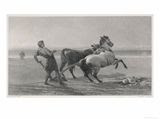Eye tracking is a process that describes where a person’s gaze focuses and how their eyes and head move in corresponding motion, and it is used to measure exactly what a person’s gaze focuses on and the length of time the gaze stays fixated on the object. Formal observations of eye tracking movements are generally believed to have been around for at least 100 years.
In various histories of ophtalmology, common knowledge states that the investigation of eye movements was first formally studied as far back as the late 1800’s by the renowned ophthalmologist Louis Emile Javal, who first noted the rapid stops or “fixations” of the eye when reading and the "saccades" or fast movement of the eyes from object to object.
This discovery was followed
by the development
of various mechanical
devices and visual aids
that were designed to
measure eye movement
and head position during
the
performance of visual tasks.
We will come back to Javal's "fixations" later in this article, but let us first look at why eye tracking gives the modern designer an important tool in design technology.
Why study Eye Tracking?
The study of eye tracking has added to our knowledge of the mechanisms of visual perception in many fields, including advances in the areas of:
In Lynne Cooke's excellent article on Eye Tracking:How It Works and How It Relates to Usability, Lynne explains how eye tracking is used to measure factors of usability in readers of print media, as eye tracking has shown that the readers tend to read text in groups of words rather than process each word seperately, often skipping the third word of a sentence and letting their brain fill in the meaning based on the overall context.
What can we learn about usability from eye-tracking?
A key factor of eye tracking is its ability to help the designer measure immersion or attachment to an object. In the Poynter Institute's "EyeTrack III" 2004 Eye Tracking Study researchers noted that Javal's "fixations" , the resting of the eye on a particular object are "are most commonly measured according to duration and frequency," and "typically last between 250 and 500 milliseconds." This is an important factor in both measuring and understanding how eye tracking works.
In television and movies, eye tracking has been used to measure where the eyes of the viewer focus during movement and whether that movement translates into acceptance or attachment of the message being advertised. An excellent example of this is seen in the following Dove anti-conformity video message regarding modern conceptions of beauty. The advertisement has been eye- tracked by ThinkEyeTrack using heat mapping technology:
How is eye-tracking being used for web and user interface design?
Eye tracking can be used to structure web design by helping the designer understand the responses of the target audience. As the Poynter Institute report showed, information taken from usability analyses done with eye tracking technology found that designers could more easily measure whether a design was successful in attracting attention by considering the following data points:
F-Pattern Heat Map
Eye movements roughly tended to follow the "F"and the "Z" pattern of design.
Small type encouraged focused reading behavior while large type promoted light scanning.
Underlined headlines discouraged reading of related information underneath the headline.
Short paragraphs were preferred over long paragraphs.
Headlines accompanied by summary descriptions were popular,with a majority of people viewing all or part of the story.
Images of at least 210 X 230 pixels received more eye traffic than smaller images, and people frequentlyclicked on the 210 X 230 pixel images.
For a practical demonstration of how web design can be improved for usability with eye-tracking technology, take a look at this demonstration of creating an effective design for an online banking customer using statistical analysis reports that were derived from eye tracking analyses.
In this post I have tried to use some of the principles I learned while studying eye tracking usability, such as constructing the text to match typical heat mapping patterns, using short paragraphs, varying the size of the text, using bolded titles, bullet lists and visual assists to help the reader engage with the article. Can you tell me if you found it effective?





















